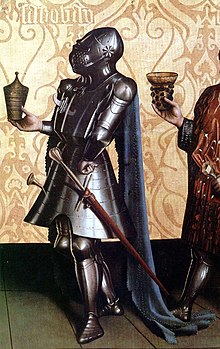This article includes a list of general references, but it lacks sufficient corresponding inline citations. (December 2021) |
Kasten-brust armour (German: Kastenbrust — "box-shaped breast") — is a German form of plate armour from the first half of 15th century.

Kasten-brust armour was a style of early gothic armour widely used in the Holy Roman Empire. Typical harness construction consists of: a grand-bascinet helm or a bicoque helmet, box-shaped cuirass, gauntlets with a long cuff and a rectangular cutout and a plate skirt known as a tonlet. Only four verified breastplates are known to have survived until today and are housed in Kelvingrove Museum in Glasgow, the Metropolitan Museum of Art in New York, German Historical Museum in Berlin,[1] and Rathaus Museum of Vienna.
Kasten-brust armour is widely represented by paintings and statues of the first half of the 15th century. A style featuring a sharp ridge at the apex of the breastplate first shows up in art during the first decade of the 15th century. By 1420 a more rounded shape begins to appear in art, sometimes with fluted embellishments. This style did not necessarily supplant the earlier style- both variety appear alongside each other in the lower left panel of the Ghent Altarpiece, which was completed in 1432. The style apparently fell out of widespread use in most of Europe by 1450, however frescoes found in Gierslev Sogn indicate the style remained in use in Denmark into the last quarter of the 15th century.
Gallery
edit-
Knights in kasten-brust armours (altar of Saint Bavo Cathedral in Ghent by Jean van Eyek, 1427–30)
-
A statue of Arthur from the Great Ancient Kings Kenotath in Innsbruck (Austria), one of several examples of Kasten-Brust armor worn by the statues within Maximilian's tomb, this particular example displaying anachronism
External links
editReferences
edit- ^ Goll, M. (2008). Eine bisher unbekannte Kastenbrust des berliner Zeughauses.
- Osprey-Military "German Medieval Armies 1300-1500" (Men-at-Arms Series t166), text by Christopher Gravett, colour plates by Angus McBride, editor Martin Windrow, Reed International Books Ltd., ISBN 0-85045-614-2 "
- Goll, M. (2008). Eine bisher unbekannte Kastenbrust des berliner Zeughauses.